Congratulations to the 50 year old Metsähovi Radio Observatory
Exactly 50 years ago on April 11, 1974, the radio telescope in Kirkkonummi moved for the first time, and since then it has gathered data from outer space 24 hours a day, 365 days a year.
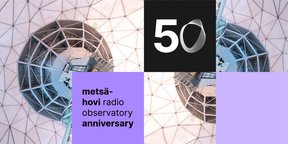
This year, Aalto University’s Metsähovi Radio Observatory will celebrate its 50th anniversary. The main radio telescope, when installed in the Metsähovi radio laboratory of Aalto University’s predecessor the Helsinki University of Technology, gave Finnish researchers access to large-scale radio science and radio astronomy research projects.
Located in Kylmälä, Kirkkonummi, the radio telescope is 13.7 metres in diameter. From within its protective dome, it gathers data from outer space 24 hours a day, 365 days a year. In addition, Metsähovi Radio Observatory also has several smaller radio telescopes and antennas for studying outer space and various radio-frequency phenomena.
‘Radio technology developed rapidly from the 1960s onwards. The Finnish Government got involved in this trend through the Postal and Telegraph Authority (nowadays Telia) – which was particularly interested in experiments and research related to satellite communications – and through the Finnish Broadcasting Company, which wanted to develop its expertise in space-based communications. Experience gained from using and developing the equipment of the Radio Research Station – nowadays the Radio Observatory – was considered of great value,’ recounts Joni Tammi, Director of Metsähovi Radio Observatory, from the observatory’s archives.
The Metsähovi Radio Observatory began operations 50 years ago as a radio research station, as its early research focused on developing radio astronomy technology. Metsähovi continues to be a key player in the field of VLBI technology, which combines radio telescopes located around the world to function as a single instrument whose resolution corresponds to that of a planet-sized telescope. VLBI stands for ‘very long baseline interferometry’, a technology whose accomplishments include the first images of a black hole.
‘In the last ten years, we have moved increasingly into observatory activities, and Metsähovi is now one of the major research and teaching infrastructure at Aalto University, with its core activities also including radio astronomy and teaching on space-related radio technology. Our strength is in long-term observation activities, and we are nowadays among only a few places worldwide which focus on long-term monitoring of active galaxies and Solar variations at high radio frequencies,’ Tammi continues.
‘Typically, researchers get telescope access only for some hours at a time, and observations are only carried out once. The goal is get a clear picture of what the object looks like in the present. We, however, are regularly monitoring hundreds of objects, enabling us to say what these objects are doing. Long time series provide context, without which it is impossible to know whether an individual observation represents the normal behaviour of an object, or whether observations have been made precisely when an entirely exceptional, “once in a lifetime” event is taking place in the object,’ he explains.
Today, the observation activities of Metsähovi Radio Observatory include three main areas: research on active galaxies, radio monitoring of the Sun, and joint observations in collaboration with international radio telescope networks.
‘We are also using building an entirely new instrument fully based on donations: a radio interferometer consisting of smaller 5.5-metre radio telescopes. Unlike the international VLBI network, which consists of radio telescopes all around the globe, all of these new telescopes will be located in Metsähovi. We hope to have the first pair of telescopes connected up at some point this year,’ Tammi adds.
The Metsähovi Radio Observatory has undergone a number of transformations over the last 50 years. The original laboratory wing served as the main building until 2021, when the new main building was completed and the old one demolished.
‘Our main instrument – a 13.7-metre diameter radio telescope – has been updated several times, for example its main reflector (the large parabolic dish) has been changed to a more accurate one. We have also modernised the control system, which must operate with extreme precision, and the radio telescope’s protective dome has been replaced twice. In addition, the telescope’s receivers – the heart of the whole system – have been updated and the range of available receivers has been expanded. We are currently working on the latest generation of multi-frequency receivers, which will open up completely new possibilities for research and use,’ Tammi continues.
The macrotrends of digitalisation and automation have also brought huge changes to the observatory’s equipment and operations over the years. Before the development of remote connections, the control commands for the radio telescope were given with the control deck computer, which meant that someone needed to be there 24 hours a day, seven days a week.
Joni Tammi’s most indelible memories are from his first weekend nights spent at Metsähovi. At the beginning of the 21st century, the telescope’s observations were still being recorded with a plotter, which drew in real time the intensity levels of the objects observed by the telescope, and the observatory worker’s job included replacing the plotter’s pens.
‘As a first-year astronomy student from the University of Turku, I eagerly travelled to the observatory to take a weekend shift and provide the actual staff with a moment’s break. My shift began on Friday afternoon and ended on Monday morning, and all this time I had to monitor the weather and the progress of observations and measurements, make corrections to the measurement system, adjust cabling and many other things. The weekend was memorable, although I accumulated enough sleep debt to understand the importance of bringing a sleeping bag the next time and making better use of micro breaks on the sofa,’ Tammi recalls.
The jubilee year will feature in Aalto University’s various information channels throughout the year, and there will also be events held and a series of public lectures in the autumn. Details of these will be released during the spring. Follow metsahovi.aalto.fi to stay up to date.
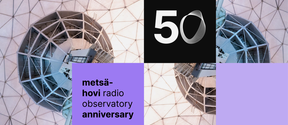
Exactly 50 years ago on April 11, 1974, the radio telescope in Kirkkonummi moved for the first time, and since then it has gathered data from outer space 24 hours a day, 365 days a year.
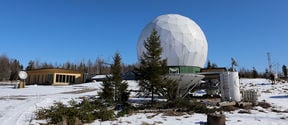
Together with other observatories around the world, Aalto University’s Metsähovi Radio Observatory has captured an unprecedented image of a black hole.

The renovation of Finland's only radio observatory is an investment into national astronomical research.

Researchers from Aalto University, the University of Turku and the Finnish Centre for Astronomy with ESO were part of the international research group in taking a revolutionary picture.
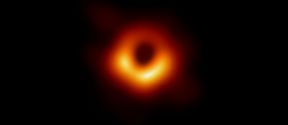
Aalto University contributed to paradigm-shifting observations of the gargantuan black hole at the heart of distant galaxy Messier 87
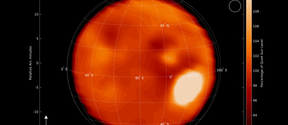
The amount of data Metsähovi receives from the Sun is huge and is growing daily with new findings.

By donating to the School of Electrical Engineering you will help creating more intelligent and sustainable future.



